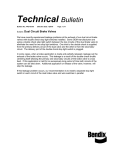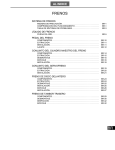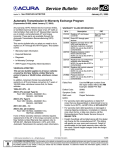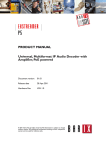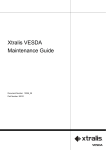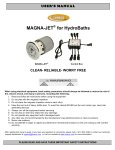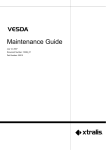Download Service Manual
Transcript
BR–5 BRAKE – BRAKE FLUID BRAKE FLUID BRAKE BLEED AIR NOTICE: • When a brake system is removed or installed, or when air in the brake line is suspected, bleed air from the brake system. • Do get brake fluid on painted surfaces. If brake fluid comes into contact with any painted surfaces, wash the fluid off immediately. 1. BLEED AIR FROM BRAKE SYSTEM (WITHOUT VSC) SST O9023-00100 (a) (b) C138736 Refill the brake fluid. (1) Place the brake fluid container upside-down on the reservoir. NOTICE: Check that there is sufficient brake fluid in the container. Bleed air from the master cylinder. HINT: When a master cylinder is removed or installed, or when the reservoir is empty, bleed air from the master cylinder. (1) (2) Using the SST, disconnect the 2 brake tubes from the master cylinder. Slowly depress the brake pedal, and keep it down. C138737 (3) C138738 BR (c) Cover the tube holes with your finger, and release the brake pedal. (4) Then, remove your fingers, slowly step on the brake pedal, and hold it in that position. Cover the tube holes with your finger, and release the brake pedal. Repeat this action 3 or 4 times. (5) Using the SST, connect the 2 brake tubes to the master cylinder. Torque: 15.2 N*m (155 kgf*cm) Bleed air from the brake system. (1) Connect a vinyl tube to the bleeder plug. (2) Depress the brake pedal several times, and while holding the pedal down, loosen the bleeder plug. (3) When the brake fluid stops coming out, temporarily tighten the bleeder plug. Then release the brake pedal. (4) Repeat this procedure until the air in the brake fluid is completely bled out. BRAKE – BRAKE FLUID BR–6 (5) (d) (e) (f) Tighten the bleeder plug. Torque: 8.4 N*m (86 kgf*cm) (Front disk brake bleeder plug) 8.5 N*m (87 kgf*cm) (Rear drum brake bleeder plug) (6) Repeat the above procedure for each wheel to bleed the air from the brake lines. NOTICE: Bleed air from the brake lines of all wheels until air is completely bled out. Inspect a brake fluid level. (1) Check the brake fluid level. If necessary, refill the brake fluid up to the MAX line on the reservoir. Bleed air from the actuator. NOTICE: • After bleeding air from the brake system, if the correct height or feel of the brake pedal cannot be obtained and it is possible that there is air in the fluid, perform the following procedure for bleeding out the air. • Use the DS-II to bleed out the air. Bleeding out the air without using the DS-II may cause injury or serious accident. (1) Turn the ignition switch off (LOCK) and depress the brake pedal at least 20 times. (2) With the ignition switch off (LOCK), connect the DS-II to the DLC. (3) Turn the ignition switch to the ON position. NOTICE: Do not start the engine. (4) Turn the DS-II on and depress the brake pedal with a force of 196 N (20 kgf) and hold it. (5) With the brake pedal depressed, following the prompts on the DS-II screen, select the secondary repair air active test and activate the actuator. HINT: • To protect the actuator, the actuator's operation will automatically stop in approximately 5 seconds. • During this time, the brake pedal attempts to return to the released position. Hold the brake pedal with a force of 196 N (20 kgf). (6) Release brake pedal (7) Connect the vinyl tube to the bleeder plug at the front right wheel. (8) Depress brake pedal several times. (9) With the brake pedal depressed, loosen the bleeder plug. (10) When the brake fluid stops coming out, temporarily tighten the bleeder plug. Then release the brake pedal. (11) Repeat this procedure until the air in the brake fluid is completely bled out. (12) Tighten the bleeder plug. Torque: 8.4 N*m (86 kgf*cm) (Front disk brake bleeder plug) (13) Bleed the air from the front left wheel using the same procedures. Repeat steps (d) through (m) until air is completely bled out. BR BR–7 BRAKE – BRAKE FLUID (g) 2. Bleed the braking system for all of the wheels. BLEED AIR FROM BRAKE SYSTEM (WITH VSC) SST O9023-00100 (a) (b) C138736 Refill the brake fluid. (1) Place the brake fluid container upside-down on the reservoir. NOTICE: Check that there is sufficient brake fluid in the container. Bleed air from the master cylinder. HINT: When a master cylinder is removed or installed, or when the reservoir is empty, bleed air from the master cylinder. (1) (2) Using the SST, disconnect the 2 brake tubes from the master cylinder. Slowly depress the brake pedal, and keep it down. C138737 (3) C138738 (c) BR (d) Cover the tube holes with your finger, and release the brake pedal. (4) Then, remove your fingers, slowly step on the brake pedal, and hold it in that position. Cover the tube holes with your finger, and release the brake pedal. Repeat this action 3 or 4 times. (5) Using the SST, connect the 2 brake tubes to the master cylinder. Torque: 15.2 N*m (155 kgf*cm) Bleed air from the brake system. (1) Connect a vinyl tube to the bleeder plug. (2) Depress the brake pedal several times, and while holding the pedal down, loosen the bleeder plug. (3) When the brake fluid stops coming out, temporarily tighten the bleeder plug. Then release the brake pedal. (4) Repeat this procedure until the air in the brake fluid is completely bled out. (5) Tighten the bleeder plug. Torque: 8.4 N*m (86 kgf*cm) (Front disk brake bleeder plug) 8.5 N*m (87 kgf*cm) (Rear drum brake bleeder plug) (6) Repeat the above procedure for each wheel to bleed the air from the brake lines. Bleed air from the actuator. NOTICE: • After bleeding air from the brake system, if the correct height or feel of the brake pedal cannot be obtained and BRAKE – BRAKE FLUID (e) (f) BR–8 it is possible that there is air in the fluid, perform the following procedure for bleeding out the air. • Use the DS-II to bleed out the air. Bleeding out the air without using the DS-II may cause injury or serious accident. Bleed air from the actuator intake system. NOTICE: • Bleed the air from the actuator intake system at the front wheels of the vehicle. (1) Turn the ignition switch off (LOCK) and depress the brake pedal at least 20 times. (2) With the ignition switch off (LOCK), connect the DS-II to the DLC. (3) Turn the ignition switch to the ON position. NOTICE: Do not start the engine. (4) Loosen the bleeder plug of the front right wheel. (5) Turn the DS-II on. Following the prompts on the DS-II screen, select the secondary repair air active test and activate the actuator. HINT: • To protect the actuator, the actuator's operation will automatically stop in approximately 5 seconds. • Release the brake pedal. (6) On the DS-II screen, confirm that the operation is stopped. (7) With the bleeder plug loosened, repeat the above procedure, from the start operation to the stop operation of the actuator, until the air is completely bled out. (8) Tighten the bleeder plug. Torque: 8.4 N*m (86 kgf*cm) (Front disk brake bleeder plug) (9) Press RETURN on the DS-II. (10) Perform the same procedure for the left front wheel. Bleed air from the actuator pressure reduction line. NOTICE: Bleed air from the actuator pressure reduction lines of all 4 wheels, one at a time. (1) Loosen the bleeder plug of the front right wheel. (2) Following the prompts on the DS-II screen, select the tertiary repair air active test and active the actuator. At the same time, depress and hold the brake pedal. NOTICE: • Although the pedal force of the brake pedal may be heavy, try to step on so that the brake fluid come out from the bleeder plug. • Keep the brake pedal depressed. Do not pump the brakes. HINT: To protect the solenoid, the actuator will automatically stop after approximately 5 seconds. If it is necessary to operate the actuator repeatedly, allow at least a 20 second interval between each operation. BR BR–9 BRAKE – BRAKE FLUID (3) (g) (h) (i) BR Tighten the bleeder plug, then release the brake pedal. Torque: 8.4 N*m (86 kgf*cm) (Front disk brake bleeder plug) 8.5 N*m (87 kgf*cm) (Rear drum brake bleeder plug) (4) Press RETURN on the DS-II. (5) For the remaining three wheels, perform the same procedure as that for the right front wheel. Bleed air from the actuator intake system and the actuator pressure reduction line until air is completely bled out. Repeat the standard procedure for bleeding air from the brake system by pumping the brakes. NOTICE: Bleed air from the brake lines of all wheels until air is completely bled out. Inspect a brake fluid level. (1) Check the brake fluid level. If necessary, refill the brake fluid up to the MAX line on the reservoir.





